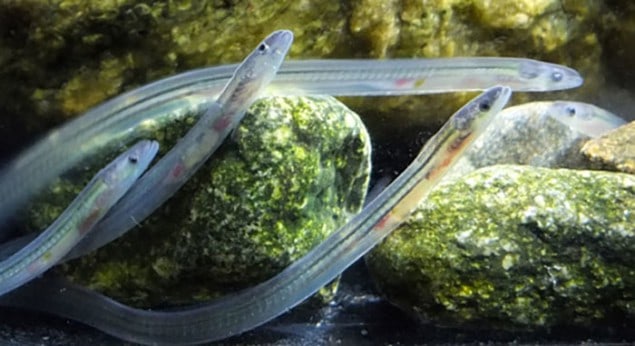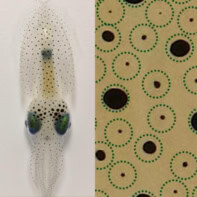Flash Physics is our daily pick of the latest need-to-know developments from the global physics community selected by Physics World‘s team of editors and reporters

Glass eels have a magnetic compass linked to the tides
European eels could navigate tricky coastal waters using the Earth’s magnetic field, according to researchers in the US and Norway. The eels begin their lives in the Sargasso Sea and then migrate thousands of kilometres to the coasts of Europe and North Africa, where they enter rivers and spend their adult lives in fresh and brackish water. Scientists believe that much of this journey is made in the larval stage by hitching a ride with the Gulf Stream current that travels from the Sargasso Sea to Northern Europe. When they reach the European continental shelf, the larvae become “glass eels”, which peel off the current and head for the coast. European eels have recently suffered a large decline in numbers and how the glass eels find their final destinations while being buffeted by tides and currents is of great scientific interest. Now, researchers at the University of Miami and the Norwegian Institute of Marine Research have shown that the eels use Earth’s magnetic field to determine which direction to swim. In a Norwegian fjord, they placed locally caught glass eels in a mesh container that was suspended from a surface float. A camera recorded the behaviour of the eels and the team found that they tended to swim in a southerly direction at ebb tides. The same glass eels were then placed in a specially designed tank in which they are shielded from external stimuli such as daylight. Magnetic fields were applied to the tank, which effectively rotated the magnetic north–south axis by 90°. During periods of ebb tides, the team found that the eels oriented themselves in a southerly direction as defined by the applied magnetic field. This led them to conclude that the glass eels navigate using Earth’s magnetic field in a manner that is linked to the local cycle of tides. This, they believe, could help the eels to use the tides to reach freshwater in rivers. “It is incredible that these small transparent glass eels can detect the Earth’s magnetic field,” says Miami’s Alessandro Cresci. “The use of a magnetic compass could be a key component underlying the amazing migration of these animals,” he adds. “It is also the first observation of glass eels keeping a compass as they swim in shelf waters, and that alone is an exciting discovery.” The study is described in Science Advances.
Ancient alignment of giant galaxies puzzles astronomers

Massive galaxies became aligned with their surroundings before the universe reached a third of its current age, astronomers report. The orientation of a galaxy is one of the easiest properties to observe. While most are randomly orientated with respect to their surroundings, some have a preferred alignment – this particularly applies to giant elliptical galaxies at the centres of rich galaxy clusters. The reason behind why these massive galaxies have an orientation, however, remains a mystery to astronomers. Michael West of Lowell Observatory in the US and collaborators therefore used the Hubble Space Telescope to observe 65 distant galaxy clusters. The team found that the galaxies have been aligned for at least 10 billion years – the earliest the phenomenon has been seen. “It’s an important new piece of the puzzle,” says West, “because it says that whatever caused these alignments happened early.” However, it is still unclear how the alignment occurred, and the team suggest several possible theories in their paper in Nature Astronomy. One theory is that the galaxies aligned with the surrounding matter at the time of formation, while another attributes it to the gravitational pull of neighbouring galaxies slowly orientating the largest.
Research productivity rises in Spain despite resource decline
Universities in Spain have seen a rise in scientific productivity and impact despite a decrease in resources and researchers. This is according to a report by the IUNE Observatory, run by the 4U Alliance. The report considers the research activity at 79 public and private Spanish universities between 2006 and 2015. IUNE found that funding for research and development diminished by 19% between 2008 and 2014. The number of scientific researchers was also seen to decline by 9.1% between 2010 and 2015, although the number of professors slightly increased. Despite these falling resources, the average number of publications per professor per year increased from 0.46 in 2006 to 0.83 in 2015. IUNE also reports an increase in research visibility and impact. The percentage of publications in the top 25% of journals based on impact factor rose from 49% to 53%. International scientific collaboration also saw a rise, with the US, UK and Germany being the top collaborators. The field of physics and astronomy are cited as the main areas where international collaboration has increased, due to projects such as those at CERN.



